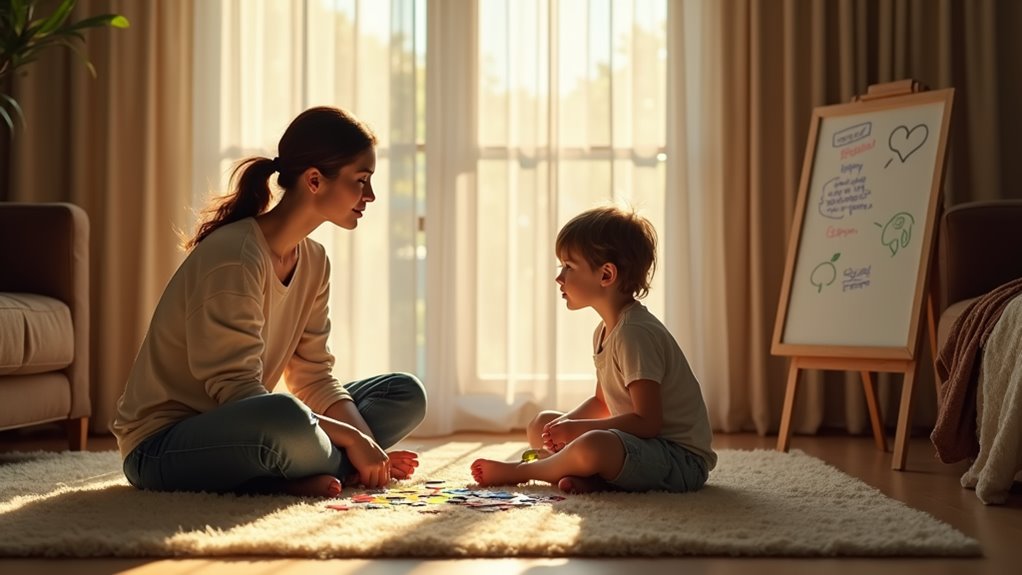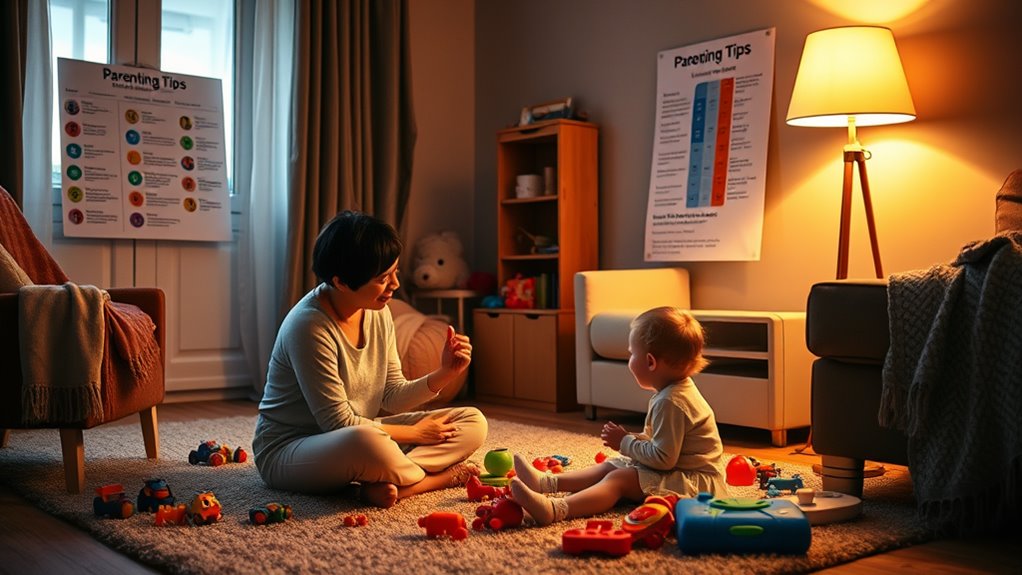When you’re facing conflict with your kids, try these effective techniques. First, understand their triggers, like hunger or tiredness. Listening actively shows you value their feelings. Create ground rules that promote respect, like no yelling. Use “I” statements to express your thoughts without blaming anyone—it’s like magic for calming things down! Encourage everyone to brainstorm solutions together; even silly ideas can lead to great ones. After resolving an issue, reflect on what worked and celebrate those small victories. Remember, every conflict is a chance to grow closer. Stick around, and you’ll discover more techniques to make parenting a bit easier!
Understanding Conflict Triggers
Understanding conflict triggers is essential for parents who want to create a harmonious home environment. You know those moments when everything seems fine, but suddenly, chaos erupts? That’s often due to unrecognized triggers. These triggers can be anything from hunger pangs to tiredness or even the way a sibling looks at them. It’s important to pay attention to what sets off these little explosions.
Take time to observe your kids. Maybe they start squabbling right after school, when they’re worn out and cranky. Or perhaps the drama unfolds during dinner when everyone’s hangry. By pinpointing these patterns, you can help prevent conflicts before they begin.
Also, don’t forget about your own triggers! You might snap when you’re stressed from work or haven’t had your coffee yet. Recognizing your own limits can help you keep a cool head.
Creating a calm environment, like having quiet time or a snack station ready, can also work wonders. It’s all about setting the stage for peace.
With a little awareness, you can turn potential arguments into opportunities for connection and understanding. And trust me, your home will thank you for it!
Active Listening Skills
Recognizing your kids’ triggers sets the stage for better communication, and that’s where active listening comes in. When you practice active listening, you show your kids that their thoughts and feelings truly matter. It’s like giving them a warm hug with your ears!
Instead of just waiting for your turn to speak, focus on what they’re saying. Nod your head, maintain eye contact, and say little things like, “I see” or “That makes sense.” This signals that you’re genuinely engaged.
Don’t interrupt or jump to conclusions. Instead, ask open-ended questions to encourage them to share more. For example, if they’re upset about a friend, you could ask, “What happened?” This invites them to express their feelings freely.
Reflecting on their words can also help. Try saying, “So you feel sad because…” This shows you understand, and it gives them a chance to clarify if needed.
Encouraging Open Communication
Open communication is essential for building trust between you and your kids. When your children feel safe to express their thoughts, feelings, and concerns, it creates a strong bond.
So, how do you encourage that openness? Start by being approachable. Smile, and ask about their day. You might be surprised by what they share!
Make sure they know it’s okay to talk about anything, even the tough stuff. Sometimes, a little humor can lighten the mood. If they’re worried about a test, remind them that you once thought “pop quiz” was a new dance move!
Also, listen without interrupting. Show them that their words matter. Repeat back what they say to confirm you understand. This simple act shows you care and encourages them to keep sharing.
Don’t forget to share your thoughts, too! Show them that it’s a two-way street. Talk about your day, your challenges, and even your silly mistakes. This way, they’ll see that everyone has ups and downs.
Setting Ground Rules
Setting ground rules is essential for maintaining a healthy environment where conflict can be resolved effectively. Think of ground rules as the referee in a game—they keep everything fair and fun!
Start by sitting down with your kids and discussing what everyone thinks is important during disagreements. Make sure everyone feels heard because it’s a team effort!
You might want to agree on some basics, like no yelling or name-calling. It’s also helpful to encourage taking turns when speaking. This way, everyone gets a chance to express their feelings without interruptions. You could even add a fun twist—like using a silly talking stick that gets passed around! That’ll keep things light-hearted.
Once you’ve set these rules, write them down and hang them up somewhere visible. Remind each other of these rules when things get heated.
Remember, it’s not about winning or losing; it’s about understanding each other better. So, when conflicts arise, refer back to those ground rules. By sticking to them, you’ll create a safe space where everyone feels comfortable sharing their thoughts.
And who knows? You might even find a way to laugh together in the end!
Using “I” Statements
Once you’ve established ground rules, it’s time to focus on how you communicate during conflicts. One powerful tool you can use is the “I” statement. Instead of saying, “You never listen to me,” try saying, “I feel ignored when I’m talking.” This shift changes the tone of the conversation and helps you express your feelings without blaming the other person.
When you use “I” statements, you take ownership of your emotions. It makes it easier for the other person to listen and understand where you’re coming from.
You might say, “I get frustrated when things aren’t cleaned up because it feels overwhelming.” This way, you’re sharing your feelings rather than pointing fingers.
Finding Common Ground
Finding common ground during conflicts can transform a heated discussion into a collaborative problem-solving session. When you’re at odds, it’s easy to focus on what divides you, but shifting your attention to shared goals can work wonders.
Start by identifying what you both want. Maybe it’s a peaceful home or happy kids. Whatever it is, keep it in mind!
Next, listen carefully to each other’s viewpoints. You might be surprised to find some overlap. For example, if one of you wants a later bedtime and the other insists on an earlier one, there’s common ground in wanting your child to be well-rested. Who knew bedtimes could be a negotiation game?
Once you find that common goal, brainstorm together. Instead of competing, think of creative solutions. You could compromise on a bedtime that works for everyone, and even reward good behavior with extra time on weekends.
Practicing Empathy
Practicing empathy can be a game-changer when maneuvering conflicts with your partner. It’s all about putting yourself in their shoes and understanding how they feel. When you start to see things from their perspective, it can really help to calm things down.
Imagine your partner’s frustration over a messy living room. Instead of just getting annoyed, think about how their day might’ve been exhausting. You might say, “I get it, you’re tired, and a messy room just adds to the stress.” This simple acknowledgment can make your partner feel heard and valued. Plus, it opens up a pathway for a more productive conversation.
Time-Out Strategies
Taking a moment to step back during a heated moment can be incredibly beneficial for resolving conflicts with your partner. When tensions rise, a time-out strategy can work wonders. Think of it as hitting the pause button on a video game—sometimes, you just need a breather to clear your head.
When you feel emotions boiling over, suggest a short break. You can say something like, “Let’s take five minutes to cool off.” During this time, do something relaxing. Maybe grab a glass of water, take a few deep breaths, or even step outside for a minute. This isn’t about avoiding the issue; it’s about giving yourself space to think clearly.
After your time-out, come back with a fresh perspective. You’re likely to be calmer and more open to listening. It’s like returning to the game with a new strategy—your approach can change everything.
Collaborative Problem Solving
Collaboration is key when it comes to resolving conflicts with your partner. Instead of arguing, try working together to find solutions. Start by sitting down with your partner and talking openly about the issue at hand. Make sure both of you get a chance to share your feelings and thoughts. It’s like being on a team—your goal is to score a win for both sides!
Next, brainstorm ideas together. Grab a piece of paper and jot down all possible solutions, no matter how silly they might seem. Sometimes the craziest ideas spark the best solutions!
Once you have a list, discuss each option and see which one works best for both of you. Remember, it’s not about who’s right or wrong; it’s about finding a solution that makes you both happy.
Lastly, agree on a plan and set a time to revisit it. This way, you can see how well your solution is working. If it’s not, don’t be afraid to tweak it!
Conflict isn’t fun, but using collaboration can turn a disagreement into a chance for growth and understanding. Plus, it’s way better than a shouting match!
Reflecting on Resolutions
After working together to find a solution, it’s important to reflect on the resolutions you’ve reached. This step is like a team huddle after a big game. You want to check in and see how everyone feels about what you decided.
Ask yourself, are the solutions working? Is everyone happy? Sometimes, it’s easy to just move on, but taking a moment to think can make a big difference.
Talk with your kids about what went well and what could be better. Did they feel heard? Was the resolution fair? You might discover their ideas for improvement are pretty insightful. Plus, this shows them that their opinions matter, and that’s a win for everyone.
Don’t forget to celebrate the small victories! Acknowledge the effort you all put in to solve the conflict. Maybe even share a laugh about the whole situation.





